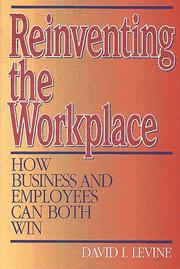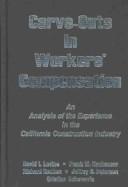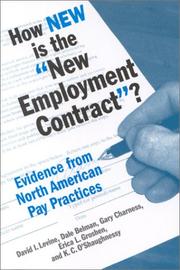| Listing 1 - 9 of 9 |
Sort by
|

ISBN: 0815752326 0815752318 Year: 1995 Publisher: Washington, D.C. : Brookings Institution,
Abstract | Keywords | Export | Availability | Bookmark
 Loading...
Loading...Choose an application
- Reference Manager
- EndNote
- RefWorks (Direct export to RefWorks)
Business policy --- Personnel management --- United States --- Industrial management --- Job satisfaction --- Labor productivity --- Total quality management --- Teams in the workplace --- Gestion d'entreprise --- Satisfaction au travail --- Qualité totale --- Equipes de travail. --- Employee participation --- Psychological aspects --- Participation des travailleurs --- #SBIB:316.334.2A553 --- #SBIB:316.334.2A551 --- Personeelsbeleid en loonbeleid, functieclassificaties --- Partijen en strategieën in de onderneming: ondernemingsbeleid en management --- Qualité totale --- Quality management, Total --- TQM (Total quality management) --- Management --- Total quality control --- Groups, Work --- Team building in the workplace --- Team work in the workplace --- Teambuilding in the workplace --- Teams, Work --- Teamwork in the workplace --- Work groups --- Work teams --- Social groups --- Work environment --- Labor output --- Productivity of labor --- Industrial productivity --- Capital productivity --- Hours of labor --- Labor time --- Productivity bargaining --- Occupational satisfaction --- Work satisfaction --- Quality of work life --- Satisfaction --- Job enrichment --- United States of America

ISBN: 0585469695 9780585469690 0880992387 9780880992381 0880992379 9780880992374 Year: 2002 Publisher: Kalamazoo, Mich. W.E. Upjohn Institute for Employment Research
Abstract | Keywords | Export | Availability | Bookmark
 Loading...
Loading...Choose an application
- Reference Manager
- EndNote
- RefWorks (Direct export to RefWorks)
Workers' compensation --- Construction industry --- Business & Economics --- Labor & Workers' Economics --- Building industry --- Home building industry --- Building
Book
Year: 2014 Publisher: National Bureau of Economic Research
Abstract | Keywords | Export | Availability | Bookmark
 Loading...
Loading...Choose an application
- Reference Manager
- EndNote
- RefWorks (Direct export to RefWorks)
Digital
Year: 2014 Publisher: Cambridge, Mass. National Bureau of Economic Research
Abstract | Keywords | Export | Availability | Bookmark
 Loading...
Loading...Choose an application
- Reference Manager
- EndNote
- RefWorks (Direct export to RefWorks)
We estimate the impact of weather variation on agricultural output in Indonesia by examining the impact of local rainfall shocks on rice output at the district level. Our analysis makes use of local meteorological data on rainfall in combination with government administrative data on district-level rice output in the 1990s. We find that deviations from mean local rainfall are positively associated with district-level rice output. 10% higher rainfall leads metric tons of rice output to be 0.4% higher on average. The impact of rainfall on rice output occurs contemporaneously (in the same calendar year), rather than with a lag. These results suggest that researchers should be justified in interpreting higher rainfall as a positive contemporaneous shock to local economic conditions in Indonesia.
Book
Year: 1998 Publisher: New York, N.Y. Federal Reserve Bank of New York
Abstract | Keywords | Export | Availability | Bookmark
 Loading...
Loading...Choose an application
- Reference Manager
- EndNote
- RefWorks (Direct export to RefWorks)

ISBN: 0880992328 0585470286 9780585470283 9780880992312 088099231X 9780880992329 Year: 2002 Publisher: Kalamazoo, Mich. W.E. Upjohn Institute for Employment Research
Abstract | Keywords | Export | Availability | Bookmark
 Loading...
Loading...Choose an application
- Reference Manager
- EndNote
- RefWorks (Direct export to RefWorks)
US / United States of America - USA - Verenigde Staten - Etats Unis --- 332.11 --- 332.20 --- Arbeidscontract. Collectieve arbeidsovereenkomsten. --- Bezoldiging van de arbeid: algemeenheden. --- Compensation management -- Canada. --- Compensation management -- United States. --- Labor contract -- Canada. --- Labor contract -- United States. --- Labor market -- Canada. --- Labor market -- United States. --- Wages -- Canada. --- Wages -- United States. --- Wages --- Compensation management --- Labor contract --- Labor market --- Comparative industrial relations --- E-books --- Employment contract --- Contracts --- Hire --- Industrial relations --- Labor laws and legislation --- Compensation administration --- Wage and salary administration --- Personnel management --- Arbeidscontract. Collectieve arbeidsovereenkomsten --- Bezoldiging van de arbeid: algemeenheden --- Law and legislation
Book
Year: 2000 Publisher: Cambridge, Mass. National Bureau of Economic Research
Abstract | Keywords | Export | Availability | Bookmark
 Loading...
Loading...Choose an application
- Reference Manager
- EndNote
- RefWorks (Direct export to RefWorks)
Book
Year: 2014 Publisher: Cambridge, Mass. National Bureau of Economic Research
Abstract | Keywords | Export | Availability | Bookmark
 Loading...
Loading...Choose an application
- Reference Manager
- EndNote
- RefWorks (Direct export to RefWorks)
We estimate the impact of weather variation on agricultural output in Indonesia by examining the impact of local rainfall shocks on rice output at the district level. Our analysis makes use of local meteorological data on rainfall in combination with government administrative data on district-level rice output in the 1990s. We find that deviations from mean local rainfall are positively associated with district-level rice output. 10% higher rainfall leads metric tons of rice output to be 0.4% higher on average. The impact of rainfall on rice output occurs contemporaneously (in the same calendar year), rather than with a lag. These results suggest that researchers should be justified in interpreting higher rainfall as a positive contemporaneous shock to local economic conditions in Indonesia.
Book
Year: 2000 Publisher: Cambridge, Mass. National Bureau of Economic Research
Abstract | Keywords | Export | Availability | Bookmark
 Loading...
Loading...Choose an application
- Reference Manager
- EndNote
- RefWorks (Direct export to RefWorks)
We examine the relationship between wages and skill requirements in a sample of over 50,000 managers in 39 companies between 1986 and 1992. The data include an unusually good measure of job requirements and skills that can proxy for human capital. We find that wage inequality increased both within and between firms from 1986 and 1992. Higher returns to our measure of skill accounts for most of the increasing inequality within firms. At the same time, our measure of skill does not explain much of the cross-sectional variance in average wages between employers, and changes in returns to skill do not explain any of the time series increase in between-firm variance over time. Finally, we find only weak evidence of any declines in the rigidity of internal wage structures of large employers.
| Listing 1 - 9 of 9 |
Sort by
|

 Search
Search Feedback
Feedback About UniCat
About UniCat  Help
Help News
News